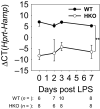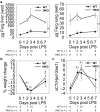Iron overload causes a mild and transient increase in acute lung injury
- PMID: 32596989
- PMCID: PMC7322498
- DOI: 10.14814/phy2.14470
Iron overload causes a mild and transient increase in acute lung injury
Abstract
Recent studies have demonstrated a strong link between acute respiratory distress syndrome (ARDS) and the levels of iron and iron-related proteins in the lungs. However, the role of iron overload in ARDS development has yet to be characterized. In this study, we compared the highly iron-overloaded hepcidin knockout mice (HKO) to their iron-sufficient wild-type (WT) littermates in a model of sterile acute lung injury (ALI) induced by treatment with oropharyngeal (OP) LPS. There were no major differences in systemic inflammatory response or airway neutrophil infiltration between the two groups at the time of maximal injury (days 2 and 3) or during the recovery phase (day 7). Hepcidin knockout mice had transiently increased bronchoalveolar lavage fluid (BALF) protein and MPO activity in the lung and BALF on day 3, indicating worse vascular leakage and increased neutrophil activity, respectively. The increased ALI severity in iron-overloaded mice may be a result of increased apoptosis of lung tissue, as evidenced by an increase in cleaved capsase-3 protein in lung homogenates from HKO mice versus WT mice on day 3. Altogether, our data suggest that even severe iron overload has a relatively minor and transient effect in LPS-induced ALI.
Keywords: ARDS; acute lung injury; inflammation; iron overload.
© 2020 The Authors. Physiological Reports published by Wiley Periodicals, Inc. on behalf of The Physiological Society and the American Physiological Society.
Conflict of interest statement
T.G. and E.N. are shareholders and scientific advisors of Intrinsic LifeSciences and Silarus Therapeutics, and consultants for Ionis Pharmaceuticals, Protagonist, Keryx Pharmaceuticals, La Jolla Pharma, Vifor, Akebia (T.G.), and Gilead (T.G.). Neither A.K. nor V.Z. have any conflicts of interest, financial, or otherwise, to disclose.
Figures





Similar articles
-
Inhibition of Pendrin by a small molecule reduces Lipopolysaccharide-induced acute Lung Injury.Theranostics. 2020 Aug 7;10(22):9913-9922. doi: 10.7150/thno.46417. eCollection 2020. Theranostics. 2020. PMID: 32929324 Free PMC article.
-
Protective effect of suppressing STAT3 activity in LPS-induced acute lung injury.Am J Physiol Lung Cell Mol Physiol. 2016 Nov 1;311(5):L868-L880. doi: 10.1152/ajplung.00281.2016. Epub 2016 Sep 16. Am J Physiol Lung Cell Mol Physiol. 2016. PMID: 27638904 Free PMC article.
-
Hepcidin knockout mice spontaneously develop chronic pancreatitis owing to cytoplasmic iron overload in acinar cells.J Pathol. 2017 Jan;241(1):104-114. doi: 10.1002/path.4822. Epub 2016 Dec 1. J Pathol. 2017. PMID: 27741349
-
PKR suppress NLRP3-pyroptosis pathway in lipopolysaccharide-induced acute lung injury model of mice.Biochem Biophys Res Commun. 2019 Oct 29;519(1):8-14. doi: 10.1016/j.bbrc.2019.08.054. Epub 2019 Aug 29. Biochem Biophys Res Commun. 2019. PMID: 31474337
-
Receptor Interacting Protein 3-Mediated Necroptosis Promotes Lipopolysaccharide-Induced Inflammation and Acute Respiratory Distress Syndrome in Mice.PLoS One. 2016 May 19;11(5):e0155723. doi: 10.1371/journal.pone.0155723. eCollection 2016. PLoS One. 2016. PMID: 27195494 Free PMC article.
Cited by
-
The Role of Ferroptosis in Acute Respiratory Distress Syndrome.Front Med (Lausanne). 2021 May 7;8:651552. doi: 10.3389/fmed.2021.651552. eCollection 2021. Front Med (Lausanne). 2021. PMID: 34026785 Free PMC article. Review.
-
Sodium Houttuyniae attenuates ferroptosis by regulating TRAF6-c-Myc signaling pathways in lipopolysaccharide-induced acute lung injury (ALI).BMC Pharmacol Toxicol. 2024 Sep 6;25(1):63. doi: 10.1186/s40360-024-00787-x. BMC Pharmacol Toxicol. 2024. PMID: 39243105 Free PMC article.
-
A mouse model characterizes the roles of ZIP8 in systemic iron recycling and lung inflammation and infection.Blood Adv. 2023 Apr 11;7(7):1336-1349. doi: 10.1182/bloodadvances.2022007867. Blood Adv. 2023. PMID: 36260707 Free PMC article.
-
Mild Attenuation of the Pulmonary Inflammatory Response in a Mouse Model of Hereditary Hemochromatosis Type 4.Front Physiol. 2021 Jan 13;11:589351. doi: 10.3389/fphys.2020.589351. eCollection 2020. Front Physiol. 2021. PMID: 33519502 Free PMC article.
-
Genetic regulation of iron homeostasis in sideropenic patients with mild COVID-19 disease under a new oral iron formulation: Lessons from a different perspective.Immunobiology. 2022 Nov;227(6):152297. doi: 10.1016/j.imbio.2022.152297. Epub 2022 Oct 26. Immunobiology. 2022. PMID: 36327544 Free PMC article.
References
-
- Bellani, G. , Laffey, J. G. , Pham, T. , Fan, E. , Brochard, L. , Esteban, A. , … Pesenti, A. ; Investigators LS and Group ET . (2016). Epidemiology, patterns of care, and mortality for patients with acute respiratory distress syndrome in intensive care units in 50 countries. JAMA, 315, 788–800. 10.1001/jama.2016.0291 - DOI - PubMed
-
- Brower, R. G. , Matthay, M. A. , Morris, A. , Schoenfeld, D. , Thompson, B. T. , & Wheeler, A. ; Acute Respiratory Distress Syndrome Network Investigators . (2000). Ventilation with lower tidal volumes as compared with traditional tidal volumes for acute lung injury and the acute respiratory distress syndrome. New England Journal of Medicine, 342, 1301–1308. - PubMed
Publication types
MeSH terms
Substances
Grants and funding
LinkOut - more resources
Full Text Sources
Research Materials
Miscellaneous

